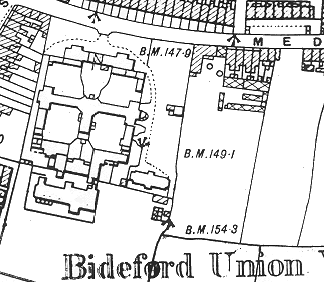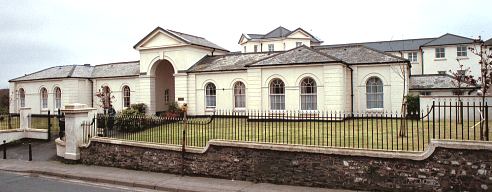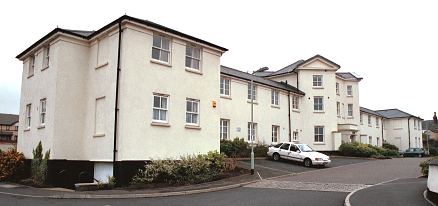Bideford, Devon
Up to 1834
In 1738, a workhouse was built in 'Maidenstreete' (Meddon Street) with a House of Correction close by. In 1777, a parliamentary report recorded that it could house up to 75 inmates. In 1830, the workhouse moved to the Colonial House on Barnstaple Street, on the east bank of the Taw.
Northam had a workhouse from around 1741 (Hitchcock, 1985). In 1777, it could accommodate 80 inmates.
The 1777 report also recorded parish workhouses also in operation at Hartland (for up to 90 inmates), Parkham (20), and Woolfardisworthy (8).
After 1834
Bideford Poor Law Union formally came into existence on 1st December 1835. Its operation was overseen by an elected Board of Guardians, 25 in number, representing its 18 constituent parishes as listed below (figures in brackets indicate numbers of Guardians if more than one):
Devon: Abbotsham, Alwington, Bideford (4), Bradworthy (2), Bulkworthy, Buckland Brewer (2), Clovelly, East Putford, Hartland (2), Landcross, Littleham, Monkleigh, Northam (2), Newton - St Petrock, Parkham, West Putford, Welcombe, Woolfardisworthy.
The population falling within the Union at the 1831 census had been 17,787 with parishes ranging in size from Landcross (population 96) to Bideford itself (4,847). The average annual poor-rate expenditure for the period 1833-35 had been £7,333 or 8s.3d. per head
A new Union workhouse was built in 1837-8 on the south side of Meddon Street in Bideford. It was designed by George Gilbert Scott and his partner William Bonython Moffatt who were also the architects for other Devon workhouses in Newton Abbot, Tiverton, and Tavistock. Intended to accommodate 200 inmates, the Poor Law Commissioners authorised the sum of £3,645 on its construction. The workhouse location and layout are shown on the OS map of 1903:

Bideford site, 1903.
The main workhouse followed Scott and Moffatt's typical design. It had a single-storey front block with a central entrance archway.

Bideford from the north, 2001.
© Peter Higginbotham.
To its rear was the main accommodation block at the centre of which was located the master's quarters, with accommodation for males to one side, and females at the other.

Bideford main accommodation block from the north-east, 2001.
© Peter Higginbotham.
An infirmary block stood at the south of the site. This was replaced by a new 40-bed infirmary in 1903 which contained a men's ward on the ground floor, with women's ward, labour ward and lying-in ward on the first floor. Its opening was reported by The Builder on 13th June, 1903.
The workhouse site later became Torridge Hospital but the surviving buildings have now been converted to residential accommodation.
Staff
Inmates
Records
Note: many repositories impose a closure period of up to 100 years for records identifying individuals. Before travelling a long distance, always check that the records you want to consult will be available.
- North Devon Record Office, Tuly Street, Barnstaple, EX31 1EL. Very few local records survive — holdings include: Guardians' minute books (1929-32); Assessment committee minutes (1904-1927); etc.
Bibliography
- Hitchcock, T.V. (1985) The English workhouse: a study in institutional poor relief in selected counties. l695-l750. (DPhil thesis. University of Oxford.)
- The Builder, 13th June, 1903.
Links
- None.
Unless otherwise indicated, this page () is copyright Peter Higginbotham. Contents may not be reproduced without permission.


